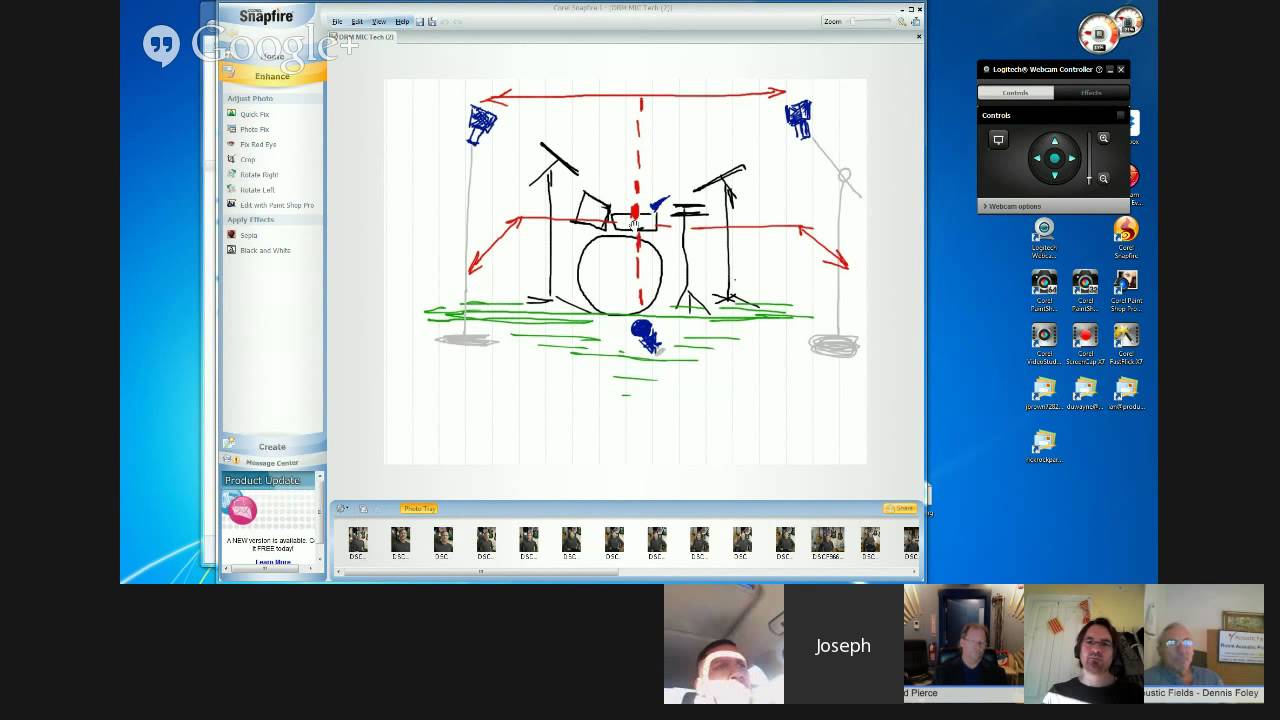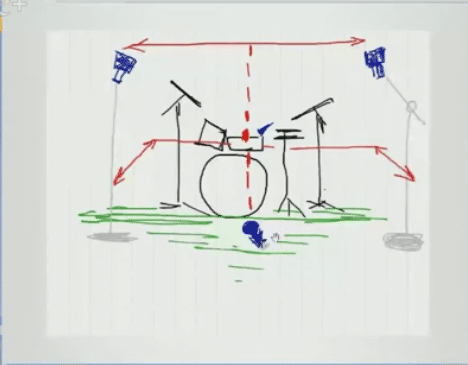In another of our monthly Google Hangouts with experienced and talented audio engineers Brad Pierce, Joseph Baffy and Joshua Wilson, we continued in our efforts to bridge the gap between what you are hearing as an engineer and how the room is causing that problem. The following video and transcript comes from one particular section where we addressed the issue “How You Should Position Mics When Recording Drums”. If you would like to see the full hour and a half discussion you can see the video further down the page.
Brad: Ah Joseph, could you go back to your screen share there and could you talk back about the distance of the microphones related to the drums and then relate the distance to the walls? Maybe you could talk about that a little bit. So the ratio of where the drums are set up in the room, if they’re close to the wall or they’re out in the middle of the wall.
Joseph: Got you, yes. I would put the drums in the middle of the biggest room we have. Provided, I mean you’re not in a gymnasium. You don’t have to be in the middle of that you know. But yes if I was going to be recording this in my basement, a set of drums in an 8-foot ceiling I would want that right in the middle of the room, maybe not dead center in the middle. I’m a little weird, I’d probably start of like a foot and a half off center just to get away from an equal measurement situation. I would keep the overhead mics, lets say we had a rectangle, I would position the drums where the overheads would be on that long side of the rectangle. Okay? So the way we’re looking at this picture, the left and right would be the long side of the room. And then from the drummer looking at this room, looking at me, that would be the short side of the room. Yeah Brad?
Brad: Yeah, absolutely.
Joseph: You got it. You know I’d start somewhere close to the center and there is a fantastic product that is a sold at a place where they have bulk sales and it’s a flooring material that is interlocking 18×18 or 24×24 pieces and it’s very inexpensive and its a fatigue mat basically. It’s something that we’ll see either in an industrial application and in a child’s play area, you know that child’s play area styles a little softer but I have several stacks of those. And because their like 25 dollars for 5 pieces and I’ll get out pull it up before this is over with and give the exact name of it. I use that under the drums.
Brad: So you’re basically decoupling the drums from the floor a little bit, yeah?
Joseph: Yeah, you got it. It’s only a half inch thick so I get no benefits like riser type of situation but you know if I’m in a small room, 8-foot ceiling room, I cant really afford a riser in that scenario.
Brad: Sure.
Joseph: Okay. I drew two different stick microphone holders. One is just your basic straight up and down and that was just to let guys starting out know whatever you have is the best thing to use. If you ask me “what’s the best mic?” I’d said the one you own. Like this mic. The SM 57 on the snare is great. If you have the dough an SM 7B, basically any mic that you see in Musician’s Friend, that costs 80 bucks. That says you know kick drum mic. If you spend the time finding where out the spot that you can put that mic, you can get a sound with it. You can get a good sound. It may be a lot harder than you know getting the sure SM7B for 350 bucks or the 80K Odens. But I really don’t worry too much about my mic selection more than I do about the placement of it. And making sure that I understand, I mean I understand it but I think others may sometimes forget your first EQ is where you put your microphone, that’s the first knob on your EQ before you get involve with anything. You know the first knob is where the microphone goes and if you can afford the time and the patience, you put the microphones wherever they need to be to get the sound you’re looking for.
And if you’re somewhat systematic about it, I think you’ll find it quicker, you know sooner rather than later you know it’s not a haphazard thing and having a piece string or a tape measure, I think as an engineer or as someone who’s going to record, I think you should have a tape measure. And you should have a just an old-fashioned pencil and a piece of paper and you take some notes. And if you do yourself a picture similar to this and where the red arrows are, you out the numbers there. You know, how many feet between the two overheads and the distance from the snare to the overhead. Then you’re building yourself a catalog. You’ll find it’s going to repeat itself more times than not, it’s going to be very close to the same measurements almost all the time regardless of where you at except for the height, that is the biggest thing that is going to change, the height of the mics.
Joshua: How does room sound play in to the mic placement?
Joseph: I would have to put it this way to you, what you’re really hearing and I think this is it, I’ve tried to come up with a quote, something that would have some kind of substantial meaning and the closest I could get to it was, “You’re hearing a room that just happens to have musicians playing it”. So you’re hearing the room, you’re going to hear the room and it’s how you game stage that’s going to dictate how much of the room you’re going to hear, there’s a certain amount that is just there, it’s going to happen because you’re in a room.
If you are light-handed on your preamps and whether you’re using a Tascam 1800 and you’re going direct into your converter, it doesn’t really matter. If you’re light handed on those preamps and keep your waveform in the sweet spot somewhere around, in Pro Tools for me it’s ten, I look at the 10 decibel mark, you know the minus ten. And you know in my Pro Tools I just look at that meter you know the fader. I look at the fader there and if its right around minus 10, minus 12, I’m okay with that as an average sound. I don’t really like it peaking past minus 6 and I work with that ratio, minus 10 to minus 6, that four decibel ratio. I look at that same span and if I’m getting too much room sound, I drop it down.
If I turn my gain structure down too far, what I’ll end up with is more room sound because then I’ll have a tendency to compress more to get what I want, possibly. Does that make sense to you Joshua?
Joshua: Yes, so what would be like, I get that, because there’s this thing like a desirable room sound in that?
Joseph: Is there such thing as a desirable room sound? It’s going to, you know, if you record a heavy metal I wouldn’t worry about.
Joshua: What’s that?
Joseph: I said, if, you know, I don’t write in heavy metal lovers. If you’re recording heavy metal you’re not going to have to really worry about the room sound. If you’re recording jazz where you’ve got a lot of air involved, then you’re going to definitely notice the room sound.
In Summary
To learn more about room acoustics and how drums interact with your room, please sign up to download our free ebooks and video series on room acoustics here. And please let me know if you have any questions at any time.
Thanks
Dennis Foley








